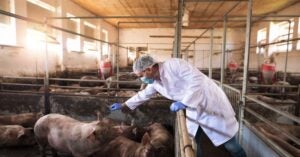Scientists from Duke-NUS Medical School and its partners have discovered several previously unknown strains of swine flu viruses. The kicker? These swine flu viruses have probably circulated in Cambodian pig populations for at least 15 years.
The previously unnoticed strains include viruses that humans have passed to pigs, and some even include genes with originals as far as North America.
The concern is that swine are a primary source of the pandemic influenza A viruses, serving as an intermediary in the emergency of virus threats, shuffling genes between avian, swine, and human hosts. Considering intensified swine production and global trade, transmission and zoonotic risk of influenza A viruses has strengthened.
For the study published in PNAS, researchers collected 4,089 nasal swabs from pigs in 18 pig slaughterhouses in Cambodia from March 2020 to July 2022. Among these, 72 pigs — or around 2 percent tested positive for influenza A virus.

Scientists identified nine distinct swine influenza A virus groups, at least seven of which had not been detected for anywhere from two to 15 years. Among these are multiple H3 lineages that had been passed by humans to pigs, circulating undetected for about ten years, as well as the H1N1 subtype, which was predominant and likely derived from human origins dating back to the 2009 pandemic.
Two seasonal viruses were also detected in pigs from Kandal, Phnom Penh, and Takeo provinces. A new swine European H1N2 variant originating with birds was also discovered with North American genes in Cambodian hogs.
“The long-term evolution of different lineages has led to the establishment of genetically distinct viruses that have been continuously circulating in pig populations undetected for decades,” said Duke-NUS’s Professor Yvonne Su, a senior and corresponding author of the study. “Our study revealed the hidden and complex genomic landscape of swine flu virus evolution in South-East Asia, marking the region as a hotspot for virus diversity and risk of new virus emergence.”
Researchers also discovered that European swine flu viruses had been introduced into South Central China and Southeast Asia in the early 2000s. Genetic evidence indicates that South Central China has been a significant source of European-like swine flu virus transmission in the region for over a decade.
“Routine and sustained surveillance is indispensable in identifying new viruses so that their transmission risk can be assessed,” said Professor Patrick Tan, Senior Vice-Dean for Research at Duke-NUS. “It is therefore critical that more efficient and continuous surveillance methods are integrated with automated analytical tools to rapidly provide information on changes in human and animal pathogens. Such a system as the team at Duke-NUS is developing would improve animal health through selection of effective vaccines, and aid in human health by monitoring viruses with the potential for transmission.”
More studies will help understand the pandemic threat of the new viruses, including how they react with human viruses and how easily they’re spread.
Researchers are developing a platform to help identify major swine flu genetic subtypes. With this program, they can assess if pig and human populations have been infected with the influenza subtypes.
»Related: Swine flu infections reported in two Michigan fair attendees


